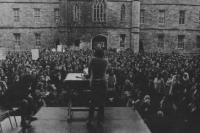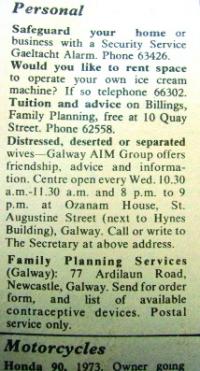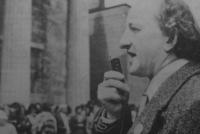‘Spreading VD all over Connacht’: reproductive rights and wrongs in 1970s Galway
Published in 20th-century / Contemporary History, Features, Issue 2(March/April 2011), Volume 19
Student general meeting in UCG in 1972. Students, well represented in the ranks of Galway’s family planning activists, had some immunity to the social pressure brought to bear by ultra-conservative Catholic groups. (TUSA)
While the social climate in 1970s urban Ireland was favourable for proponents of contraception, there were obstacles, and activism in the cause might have consequences for the individuals concerned. Galway activists—members more often of feminist-influenced socialist parties than of specifically feminist groups—therefore tended to occupy positions that gave some immunity to social pressure, pressure that was brought to bear by ultra-conservative Catholic groups, prototypical of those that would assume prominence in opposition to the ‘liberal agenda’ during the 1980s and 1990s.
Contraception was legally prohibited, but the Magee case of 1973 established that contraceptives could be imported for personal use, while the pill—available since 1962—might be prescribed as a cycle regulator. On occasion, prior to 1976, contraception made headlines in Galway—as when Labour senator and UCG lecturer Michael D. Higgins supported Mary Robinson’s 1974 Family Planning Bill. His political opponents on Galway Corporation responded by passing a resolution condemning contraception. This prompted the short-lived student-based branch of Irishwomen United to picket the corporation, causing Fine Gael TD Fintan Coogan to react: ‘It’s disgraceful—women without a ring on their fingers asking for contraceptives to be handed out!’
In late 1975/early 1976 the Galway Family Planning Association (GFPA) was established. Chairperson of the ad hoc committee was Michael Conlon, a recent UCG graduate and a supporter of Official Sinn Féin, who had taken an administrative position within the university. Others involved included medical students with a similar political orientation and staff members at UCG.
‘Sensuality without responsibility’: UCG Students’ Union takes a stand
The GFPA was barely established when the UCG Students’ Union (UCGSU) nominated it as the beneficiary of its charitable fund-raising during the annual rag week of February 1976. The sum involved—£1,000—was enough to establish a mooted family planning clinic. Outrage followed. Fifty local residents, headed by Fianna Fáil mayor Mary Byrne, addressed a public letter to the UCGSU: were students’ lives to be ‘ruled by sensuality without responsibility’, and, anyway, could contraception be regarded as a charitable purpose?
All three local papers editorialised against the allocation, the Connacht Sentinel scolding: ‘Adolescence and a seat in a university lecture hall do not give people qualifications to determine the case for or against family planning’. In a leader entitled ‘Sex and the single student’, the Galway Advertiser disclosed that student activists had political connections: ‘Certain hardliners within the students’ union have almost a fixation on what they define as “family planning” in line with the policies of the tiny political groupings to which they belong’, an allusion to Official Sinn Féin influence in student politics.

When a UCGSU general meeting narrowly reversed a previous decision to fund the newly established Galway Family Planning Association in February 1976, independent student newspaper Unity made the (unsubstantiated) claim of Opus Dei involvement. UCGSU president John Curran is holding the megaphone, while incoming USI president Eamon Gilmore is on the extreme right.
Arriving for work on Monday 16 February 1976, student union president and Official SF member Johnny Curran was surprised to find that student nuns and religious brothers were demanding an emergency general meeting of the UCGSU to rescind the assembly vote. In the course of the day, with the support of student Fine Gaelers, the principal campus rivals of Official SF, they secured more than the 150 signatures needed to summon the meeting. At lunchtime on Wednesday, accordingly, more than 1,000 students crowded into the UCG concourse to debate resolutions that would have the effect of transferring the rag week allocation to the Samaritans.
Speakers in favour of the allocation argued that a clinic would meet a ‘dire social need’; opponents insisted that the earlier assembly vote had been unrepresentative and that family planning was hardly ‘charitable’. Of almost 800 remaining after 3? hours of debate, 417 voted to give the money to the Samaritans and 379 voted for the status quo. Did the decision result from a spontaneous rebellion by ordinary students or were other forces at work? A front-page headline, ‘Opus interruptus’, in the student periodical Unity suggested Opus Dei involvement, but the claim was not substantiated. Opus Dei certainly had influence—the university was one of its key recruiting arenas (as it was for Official SF). According to Paul O’Sullivan, then treasurer of the UCGSU and an Official SF member, it was Opus Dei that coordinated the political and religious opposition to the allocation, and he recollects negotiating with an Opus Dei representative regarding the wording of the resolution of 18 February. The controversy had an impact a few weeks later, when an emboldened anti-family planning alliance took on Official SF in UCGSU elections, and Fine Gael’s Mary Carroll took the presidency.
‘Faceless people’ reveal themselvesThe GFPA’s first public event, a ‘symposium’

UCG lecturers Evelyn Stevens (left) and Pete Smith and engineering student Emmett Farrell (right) established a stopgap postal service in April 1977 with small ads (inset, Galway Advertiser) in local papers. Note the accompanying one promoting the Billings method. (Unity)
in the Ardilaun Hotel on 3
April 1976, attracted about a hundred ‘youngish’ people, according to the Advertiser—men ‘sporting fine beards’ and ‘ladies looking friendly and idealistic’. Announcing that local doctors and nurses were training in family planning, Michael Conlon addressed accusations that the GFPA was composed of ‘faceless people’. Because of the ‘unfortunate . . . rag week publicity’, he explained, they had decided to wait for the ‘rumpus to fade’ before revealing themselves. There were a small number of opponents of ‘artificial’ contraception in the room, the most vocal of whom was Deirdre Manifold, a formidable figure and the convenor of a public
rosary crusade. These opponents, according to the Advertiser, ‘were gradually subdued by laughter and, from some quarters, by rudeness’. The rudeness, almost certainly, was provoked by reported threats to ‘get at’ the
 promoters of contraception.
promoters of contraception.
If it was not evident in the Ardilaun, where opposition came from a marginal group of lay Catholics, the rag week controversy stirred influential opponents of contraception into action. In weekly ‘notes’ published in local papers, for example, the Catholic Marriage Advisory Council devoted attention to the approved ‘natural’ or Billings alternative to ‘artificial’ contraception. Moreover, a Billings clinic opened in Deirdre Manifold’s city centre premises before the GFPA was able to launch its own service.
The GFPA’s efforts to establish a clinic were hindered by a difficulty in finding premises, owners of the many empty buildings being averse to renting them to such potentially controversial tenants. In one instance an agreement with a landlord was thwarted when an existing tenant, solicitor and prominent republican Caoimhín MacCathmhaoil, announced that he was taking the additional space rather than see it go to the ‘politically motivated’ leftists of the GFPA, declaring: ‘I stand by Humanae Vitae instead of ideas imported from abroad—family planning is based on a philosophy of violence, it is anti-human and linked with abortion’.
‘Spreading VD all over Connacht’—by post
Frustrated by the lack of progress, three members of the GFPA identified with the libertarian left of the Labour Party took an initiative. UCG lecturers Pete Smith and Evelyn Stevens and engineering student Emmett Farrell decided to establish a stopgap postal service modelled on one operated by Family Planning Services (FPS) in Dublin, using Stevens’s and Farrell’s Ardilaun Road address. In April 1977 advertisements were placed in any local papers that would accept them offering condoms in exchange for ‘donations’. Responding to the claim that hundreds of letters had been received with ‘absolutely no
negative response’, one Michael Heneghan urged Ardilaun Road residents to take action:
‘There has already been a letter from the Pope . . . what does FPS need so that they’ll get the word, a picket outside their house? But it is curious about Ardilaun Road, why aren’t they protesting? It would be interesting to see their reaction if an itinerant family moved into no. 77.’
If Ardilaun Road residents did not respond to the taunts, certain others did. Emmett Farrell recalls being distracted from his studies by Manifold’s public

Labour’s Michael D. Higgins addressing worshippers outside the Franciscan church in Galway during the 1977 general election campaign. He blamed his subsequent defeat on the circulation of a leaflet targeting him ‘by an anti-contraception group’. (Galway Advertiser)
rosary group, which convened in his front garden. And there was other pressure. The parents of one publicly identified member of the group, in a village distant from the Galway diocese, were visited by a priest, advised that their son ‘was spreading VD all over Connacht’ and reminded of their duty to persuade him to change his ways. Michael D. Higgins blamed his electoral failure in 1977 on the circulation of a leaflet targeting him ‘by an anti-contraception group’. The TD recalls that, by some subterfuge, the group acquired his canvassing schedule, and sabotaged his campaign by distributing their message in estates and villages shortly before he was due to arrive.
Opening of the ‘so-called clinic’
There was encouragement from the extent of demand for the postal service, but there remained the problem of securing clinic premises. A sympathetic solicitor advised that it might be overcome if the GFPA offered substantially more than the prevailing rentals. No sooner had a contract been signed with the owner of a disused leather workshop in Raleigh Row, however, than the man had a change of heart, having received a petition signed by 284 ‘residents of St Ignatius parish’, protesting against ‘this so-called clinic’. The GFPA insisted that the contract be honoured and, on 21 July 1977, its clinic opened in Raleigh Row, offering clinical services and taking over the postal service. A hitch caused by the unavailability of the GFPA’s original volunteer doctors was overcome when Dr John Waldron, a Tuam-based GP, stepped into the breach.
‘Galway people actually wanted contraceptives’
The GFPA had to transform itself quickly into a service-provider. Steps taken included the appointment of a paid administrator, Dorothea Melvin, and the establishment of a non-profit limited company. An early list of 29 shareholders (thirteen of them women) included seven lecturers/professors, five medical doctors, two nurses, two medical representatives, two teachers, two CIE workers and a trade union official. The majority of the medical professionals were unaffiliated politically; most of the others were identified with left-wing parties—Official SF, Labour and Communist. A significant presence, informants agreed, was that of county coroner Seághan Ua Conchubhair, whose maturity and local stature were invaluable to the GFPA at a potentially difficult period in its development.
Opposition persisted, but volunteer nurses Phil Brick and Mary Fahy remember their resolve being strengthened rather than weakened by rosary crusaders outside the clinic. People arriving for consultations also had to cross the prayerful picket line, but reports to early board meetings indicate that a number sufficient to make the clinic viable did so.

Courting on Raleigh Row—on 21 July 1977 a family planning clinic finally opened in Raleigh Row, offering clinical services and taking over the postal service. (UCGSU handbook, 1979)
Within the GFPA there were differences about the character of the service, with the minority of libertarian new leftists opposing the development of what they saw as an expert-led ‘medical model’ and arguing for a more emancipatory facility, where volunteer counsellors and medical professionals would facilitate people in making decisions about their fertility and their sexuality. For the majority, however—including both trained medical people and the Official SF element—what the public required was an efficiently professional clinical service.
Raleigh Row soon proved inadequate, and larger and more central premises were secured on Merchant’s Road, but by the time the service transferred there in October 1979 the context had been changed by health minister Charles Haughey’s ‘Irish solution’. Thirty years after the controversy of 1976–7, the Galway family planning clinic is still in Merchant’s Road, though not in the same building. Some of the pioneers are still involved, and the opposition to contraception, though overcome almost three decades ago, is well remembered. Reflecting on the success of the clinic, Jimmy Brick, a family planning activist of 1976–7, draws a contrast with the fate of the other items on the agenda of his fellow leftists of that time. The difference was, he says, that ‘Galway people actually wanted contraceptives’. Of the opposition to contraception, he argues that it was counter-productive, because in drawing attention to the location of services it enabled people to avail of them. HI
John Cunningham lectures in history at NUI, Galway. He wishes to acknowledge the assistance of the Galway Family Planning Association, as well as of Jimmy Brick, Phil Brick, Michael Conlon, Johnny Curran, Mary Fahy, Emmett Farrell, Michael D. Higgins, Paul O’Sullivan, Pete Smith and Evelyn Stevens.
Further reading:
D. Ferriter, Occasions of sin: sex and society in modern Ireland (London, 2009).
B. Hanley & S. Millar, The lost revolution: the story of the Official IRA and the Workers’ Party (Dublin, 2009).
C. Hug, The politics of sexual morality in Ireland (Houndmills, 1999).
















